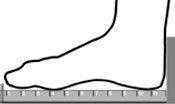Finding your perfect fit! What Clarks size are you?
Here at Clarks we know that correctly fitting shoes are important no matter what your age. Many people may not fit into a standard 'whole' size which is why we offer whole and half sizes. Wear your favourite footwear in the comfort and style that you would expect from Clarks by checking the men's, women's and kids size guides below to find your perfect fit.
Shoe Size Chart
Still unsure? Compare your size directly with our shoe size chart and measure your foot length correctly.
Also see our "Ask the expert section" for things to consider when choosing your size.
Womens & mens
| UK size chart | Clarks EU size | Standard EU Size | Foot length(cm) |
| Compare your usual shoe size to select the correct Clarks size for your order | |||
| 2 | 34 | 35 | 21.2 |
| 2.5 | 35 | 35.5 | 21.6 |
| 3 | 35.5 | 36 | 22.1 |
| 3.5 | 36 | 36.5 | 22.5 |
| 4 | 37 | 37 | 22.9 |
| 4.5 | 37.5 | 37.5 | 23.3 |
| 5 | 38 | 38 | 23.7 |
| 5.5 | 39 | 38.5 | 24.1 |
| 6 | 39.5 | 39 | 24.6 |
| 6.5 | 40 | 40 | 25 |
| 7 | 41 | 41 | 25.4 |
| 7.5 | 41.5 | 41.5 | 25.8 |
| 8 | 42 | 42 | 26.3 |
| 8.5 | 42.5 | 42.5 | 26.7 |
| 9 | 43 | 43 | 27.2 |
| 9.5 | 44 | 44 | 27.6 |
| 10 | 44.5 | 45 | 28 |
| 10.5 | 45 | 45.5 | 28.5 |
| 11 | 46 | 46 | 28.9 |
| 11.5 | 46.5 | 46.5 | 29.3 |
| 12 | 47 | 47 | 29.8 |
| 12.5 | 47.5 | 47.5 | 30.2 |
| 13 | 48 | 48 | 30.6 |
| 13.5 | 49 | 48.5 | 31 |
| 14 | 49.5 | 49 | 31.4 |
| 14.5 | 50 | 50 | 31.9 |
| 15 | 51 | 51 | 32.3 |
How to measure your foot:
Place your foot on a flat surface with your heel against a straight edge. Place a ruler beside your foot touching the straight edge your heel is also touching, then take the length in millimetres from the tip of your longest toe to your heel. Please be aware that your longest toe may not always be your big toe.

ASK THE EXPERT
Fitting advice from our shoe fitting & development team
Why does the same shoe size fit differently in different styles?
Everybody's feet are individual, but our shoes are developed to fit as consistently as possible across a range of different styles. The styling, construction or materials can affect the fit.
For example, a shoe made from patent leather may feel tighter than the same style made from soft, suede leather. This could be due to the consistency of the material and how it moves with your foot. However, leather is a natural material and may stretch over time to adapt the shape of your foot.
When we measure feet in our shops, we measure the length of the foot as well as the circumference to indicate which shoe size the customer is.
We can't make a range of shoes to accommodate each individual variation of measurements, which is why we provide many styles in half sizes and different width fittings.
How do I know which width fitting is best for me?
Our standard fit should fit most people - this is a D fit in our women's shoes and a G fit in our men's shoes. However, if your big toe joint/small toes begin to feel pinched or ache, then you may need to try a wider fit.
I have slim feet. Which styles would suit me?
People with slim feet and a low instep/arch may benefit from the use of an insock or inner sole to help reduce the excess volume inside the shoe. This can be particularly beneficial for ladies wishing to wear shoes with no effective fastening such as a court shoe.
I have a high instep. Which styles would suit me best?
Styles which are low cut on the front, and do not cover your instep are a good place to start, like loafers.
If you prefer a style with more foot coverage, then try a style with some adjustability so you can loosen the lace/buckle. Pull on boots and mule type styles are likely to give issues with foot entry.
I have a high arch - which styles will suit me best?
Try to select a style with a reasonably high cut and avoid styles with low waists such as low-slung ballerina styles and some court shoes as these will tend to gape.
I have low ankle bones and the toplines rub. What can I do?
Try adding a half insock, this will help to raise the foot slightly in the back of the shoe and raise it off the topline.
I love high heels, but they make the arches of my foot ache. What can I do?
Wedges or platform shoes can offer the height of a heel but with less of an ache in the arch of the foot. The substance of the sole in the forepart means that the arch of the foot is cranked at much less of an angle and thus aches less.
I have wider calves, which size boot/leg do I select?
Women with fuller calves should generally select wide leg boots with an 'E' fitting, as these have a wide leg.
Each whole size has a circumference that is approx. 10mm wider. On an 'E' fitting of the same size, it will be 50mm wider at the top of the leg, then 40mm wider at the lower leg blending in at the ankle.
